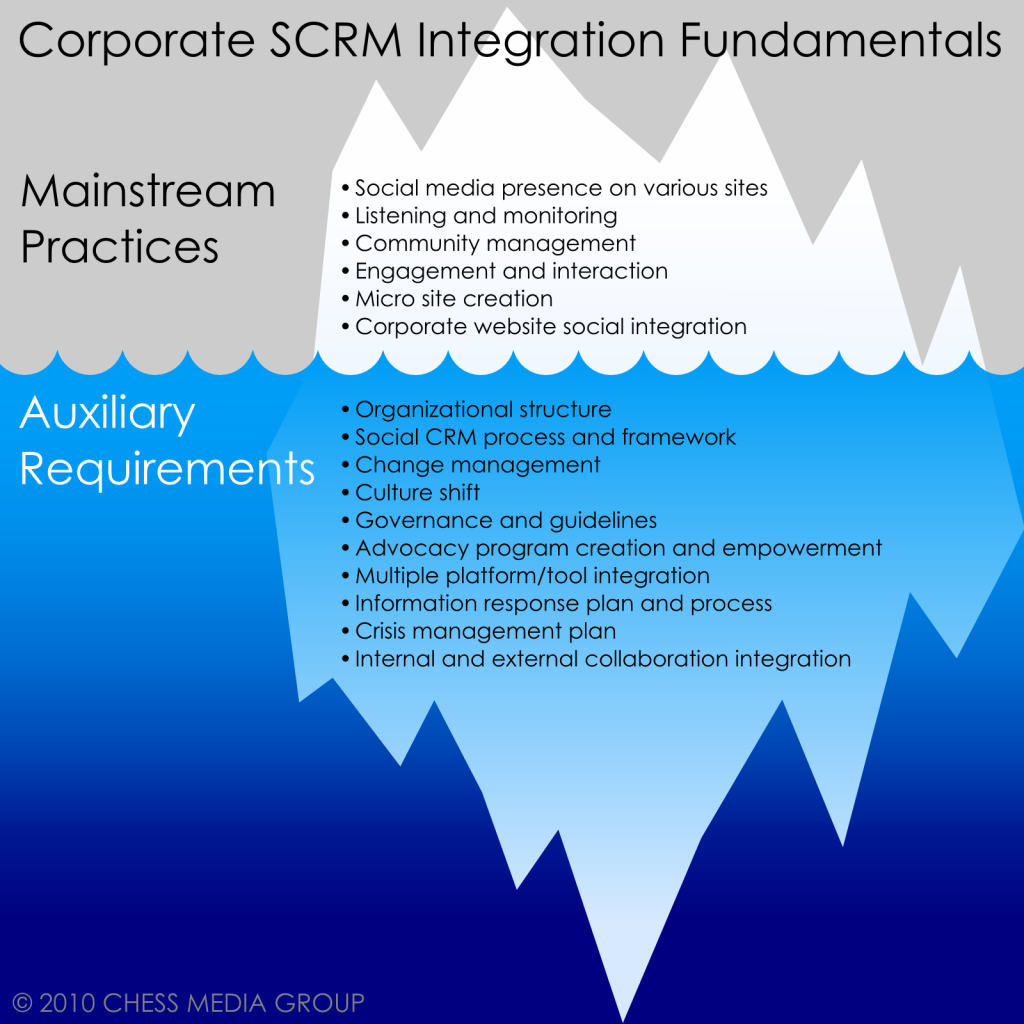In preparation for my talk on social CRM at the New Comm Forum (which I hope you will attend, see sidebar), I am once again sharing another concept/image that I will be presenting. We, at Chess Media Group are calling it “Corporate SCRM Integration Fundamentals.” The purpose of the presentation, images and ideas I have been sharing is to “get real” about SCRM. We need to stop looking at just the rudimentary practices and begin to focus on strategic business requirements and processes required to make SCRM a reality within an organization. Listening tools and social media tools such as Twitter are a great start but it’s time to move beyond that; it’s time focus on SCRM as a strategy and a part of an organization’s business processes.
Enter Corporate SCRM Integration Fundamentals:

The visual is broken up into two parts: the first are the mainstream practices which many companies are currently doing. This is what I consider to be the tip of the SCRM iceberg and include elements such as:
- social media presence on various sites
- listening and monitoring
- community management
- engagement and interaction
- micro-site creation
- corporate website social integration (“lite”)
It’s encouraging to see that companies are ‘dipping their toe into the water’, but this is just the tip of the SCRM iceberg. Companies need to look much deeper in order to fully integrate SCRM into their business processes; processes such as building relationships and empowering customers to act as advocates of the company. This is where the “auxiliary requirements” come into play (will be renamed to essential requirements). These requirements include things such as:
- organizational structure
- social CRM process and framework
- change management
- culture shift
- governance and guidelines
- advocacy program creation and empowerment
- multiple platform/tool integration
- information response plan and process
- crisis management plan
- internal and external collaboration integration
These are by no means exhaustive lists. They are designed to illustrate that companies need to go beyond the ‘entry level’ tactics. Most companies today are touching just the tip of the social CRM iceberg and are missing the core elements of what makes up SCRM. Companies should instead begin to develop long term strategies that can and should be continually implemented, adapted and evolved in a company’s efforts to integrate SCRM fundamentals and make them part of the DNA of the company.
Wim Rampen recently wrote two great posts which I think also help clarify the need for a focus on strategy and integration as opposed to tools and strict tactics (make sure to read the comments as well).
The first is: The “S” in SCRM is not about Social Media
The second is: The Only Thing your Social CRM Strategy Can NOT Do Without
I think it’s very important to look deeper at social CRM (and the social business space in general) because, as the Gartner Group states, and as I will mention in my SCRM presentation:
“By 2010 more than half of companies that have established an online community will fail to manage it as an agent of change, ultimately eroding customer value. Rushing into social computing initiatives without clearly defined benefits for both the company and the customer will be the biggest cause of failure.”
Success in the social business space isn’t going to come from tactics and “on the surface” initiatives; it’s going to come from strategies that are integrated into the company along with well-executed tactics, but the tactics come second, not first. I get the sense that many companies are putting the cart before the horse because everyone is so excited to jump on the social bandwagon and to get started with “something.” This of course is fine but we have to remember that while we are testing things out and piloting a few initiatives, we need to be preparing for the long term. Otherwise success is not going to be in sight.
Thoughts/comments/ideas? Let’s hear what you think about the Corporate SCRM Integration Fundamentals and the iceberg image.
Update: Make sure you also read Paul Greenberg’s post on Blocking and Tackling: Not Football, CRM
Comments